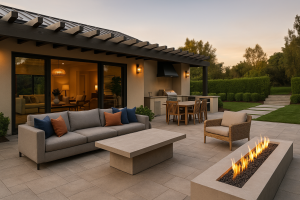Do you want to add more storage space to your kitchen or create a cozy seating area for your family and guests? Building a kitchen island out of base cabinets might be the perfect solution for you. Not only is it a rewarding DIY project, but it also allows you to create a functional and stylish addition to your kitchen without breaking the bank.
In this guide, we will walk you through the step-by-step process of creating a kitchen island using base cabinets. We will cover everything from assessing your space and needs to choosing the right base cabinets, planning the layout, assembling the island, and adding the finishing touches. Whether you’re a seasoned DIY enthusiast or a beginner, this guide will help you create a beautiful and functional kitchen island that fits your needs and style.
Assessing Your Space and Needs
Before embarking on the construction process, it is crucial to assess your kitchen space and determine your needs. This will help you determine the right dimensions of your kitchen island and ensure it fits seamlessly into your kitchen’s design.
Consider the Available Space
Take measurements of your kitchen to determine how much space is available for your kitchen island. This will help you decide on the size and shape of the island. Consider factors such as traffic flow and clearance space between the island and surrounding cabinets or appliances to ensure ease of movement in the kitchen.
Determine the Purpose
Determine the primary purpose of your kitchen island. Are you looking to increase storage space, create a seating area, or have a combination of both? This will help inform the base cabinet selections and layout of your kitchen island.
Select the Right Base Cabinets
Consider factors such as size, storage options, and style when selecting the base cabinets for your kitchen island. Look for cabinets that match your existing kitchen decor and provide the desired functionality. You can either repurpose existing cabinets or purchase new ones to suit your needs.
Remember that the base cabinets you choose will form the foundation of your kitchen island, so it is crucial to choose wisely.
Choosing the Right Base Cabinets
The base cabinets you choose will determine the overall look and functionality of your kitchen island. When selecting cabinets, there are several factors to consider, including size, style, and storage options.
If you’re repurposing existing cabinets, make sure they are in good condition and match your kitchen decor. If you’re purchasing new cabinets, measure the available space in your kitchen to determine the appropriate size. You may also want to consider cabinets with built-in storage solutions, such as pull-out drawers or specialized racks for pots and pans.
| Factor to consider | Tip |
|---|---|
| Size | Measure the available space in your kitchen to determine the appropriate size for your base cabinets. |
| Style | Choose base cabinets that match your existing kitchen decor for a cohesive look. |
| Storage | Consider cabinets with built-in storage options, such as pull-out drawers or specialized racks for pots and pans. |
By carefully considering these factors, you can choose base cabinets that are both functional and aesthetically pleasing for your DIY kitchen island project.
Planning the Layout
Before beginning the construction process, it’s important to plan out the layout of your kitchen island. This will ensure that the island fits seamlessly into your kitchen design and meets your functional needs.
Assess Your Space
The first step in planning your kitchen island layout is assessing the available space. Measure the area where you plan to install the island, taking into account any obstructions such as appliances, cabinets, or walls.
Consider traffic flow and clearance space around the island. Make sure there’s enough space for people to move around the island comfortably and that it won’t obstruct any pathways in your kitchen.
Determine Island Dimensions
Once you have assessed the space, determine the dimensions of the kitchen island. Consider the island’s purpose and how you plan to use it. Will it be primarily used for food preparation, storage, or seating?
The size of your kitchen will also play a role in determining the island’s dimensions. You’ll want to make sure that the island is proportionate to the rest of the kitchen.
Select the Layout
With the space and dimensions determined, it’s time to select the layout of your kitchen island. There are several popular layouts to choose from:
| Layout Type | Description |
|---|---|
| Galley Style | A straight-line layout with cabinets and appliances on one or both sides of the island. |
| L-Shaped | Two rows of cabinets perpendicular to each other, forming an “L” shape. |
| U-Shaped | Three rows of cabinets in a U-shape configuration. |
| Island with Attached Table | An island with a table attached, providing additional seating and workspace. |
When selecting a layout, keep in mind the island’s purpose. If the island will primarily be used for food preparation, you’ll want to maximize storage and countertop space. If the island will be used for seating, consider incorporating a table or bar seating area.
Sketch out the desired layout, taking into account the measurements of the chosen base cabinets. This will help you visualize the final result and make any necessary adjustments.
Preparing the Base Cabinets
Before assembling your kitchen island, it’s important to properly prepare the base cabinets. Here are some steps to follow:
- Remove any doors, drawers, or hardware that may interfere with the installation process. This will make it easier to work with the cabinets and ensure a secure fit.
- Clean the cabinets thoroughly to remove any dust, dirt, or debris. Any residual substances can affect the adhesiveness of screws or paint that you may use later on.
- If desired, sand the surfaces of the cabinets to create a smooth foundation for paint or stains to adhere to. Just be sure to wipe off any dust or debris afterwards.
- If you plan on painting or staining the cabinets, now is the time to do so. Follow the manufacturer’s instructions for best results.
Once your base cabinets are prepared, you’re ready to move on to the next stage of the kitchen island construction process.
Assembling the Kitchen Island
Now that the base cabinets are prepared, it’s time to start assembling the kitchen island. Follow the manufacturer’s instructions for assembling the cabinets, making sure to secure them together using screws or brackets.
Ensure that the cabinets are level and secure, making any adjustments as necessary. Take your time in this step as it will impact the overall stability and functionality of the final product.
If you plan on adding additional features, such as a seating area or sink, now is the time to make the necessary adjustments to the base cabinets to accommodate these features.
Once the cabinets are assembled and secured, you can start adding any additional features to the island. This can include electrical outlets, plumbing, or lighting fixtures.
It’s important to take your time in this stage to ensure that everything is properly installed and that the island is fully functional.
Installing the Countertop
Once the base cabinets are securely in place, it’s time to install the countertop. The countertop not only adds functionality to your kitchen island but also ties the island’s design together.
Choose a material that suits your needs and complements your kitchen’s existing design. Popular options include granite, quartz, wood, and laminate. Measure the dimensions of the island and cut the countertop accordingly. If you’re using a natural stone material, it’s best to have a professional fabricator cut and install the countertop.
| Step | Description |
|---|---|
| 1 | Place the countertop evenly on top of the base cabinets. Ensure it is flush with the edges of the cabinets and centered on the island. |
| 2 | Use adhesive or screws to secure the countertop to the base cabinets. The method you choose will depend on the type of countertop material you’re using. |
| 3 | If necessary, use a jigsaw or circular saw to cut holes for sinks or cooktops. Ensure that the holes are cut to the correct size and in the desired location. |
| 4 | Seal the edges of the countertop with silicone to prevent moisture or debris from getting in between the countertop and the base cabinets. |
Proper sealing of the countertop is essential to protect it from damage and to provide a finished look. Once the countertop is installed, the kitchen island will start to take shape and look like a professional piece of furniture.
Finishing Touches
Now that your kitchen island is assembled and the countertop is in place, it’s time to add the finishing touches. These final details will complete the look of your DIY kitchen island and make it fit seamlessly into your kitchen.
Add Decorative Moldings
One way to add a touch of elegance to your kitchen island is to install decorative moldings. These can be found at your local hardware store and come in a variety of styles to match your kitchen’s aesthetic. To install, simply measure and cut the moldings to fit your island’s dimensions, and then attach with construction adhesive.
Paint or Stain Your Island
If you want your DIY kitchen island to match the color scheme of your kitchen, consider painting or staining it. First, sand the surface of the island to ensure the paint or stain adheres properly. Then, apply the paint or stain evenly and allow it to dry completely before adding a second coat if necessary.
Install Hardware
Adding hardware such as drawer pulls and knobs can help tie your island’s look together with the rest of your kitchen. Look for hardware that matches your existing fixtures and comes in the same finish. You can find a wide variety of hardware options at your local hardware store or online.
Incorporate Additional Features
If you want to add additional features to your kitchen island, now’s the time to do it. This can include installing a sink or electrical outlets for added functionality. Just be sure to consult a professional if you’re unsure about any electrical or plumbing work.
FAQ
Q: Can I use any type of base cabinet for a kitchen island?
A: It’s important to choose base cabinets that are sturdy and can support the weight of a countertop. It’s also recommended to use cabinets that match your existing kitchen decor and provide the desired functionality. Consider factors such as size, storage options, and style when selecting base cabinets for your kitchen island.
Q: How much does it cost to make a kitchen island out of base cabinets?
A: The cost of making a kitchen island out of base cabinets can vary depending on the type of base cabinets you use, the size of the island, and any additional features you choose to incorporate. Repurposing existing cabinets can help keep costs down, while purchasing new cabinets and professional installation can increase the overall cost. It’s important to set a budget and research materials and prices before beginning the project.
Q: Do I need any special tools or skills to make a kitchen island out of base cabinets?
A: Basic carpentry skills and tools are necessary for making a kitchen island out of base cabinets. You’ll need a saw, drill, screws, and brackets, as well as a level and measuring tape. It’s important to follow the manufacturer’s instructions for assembling the base cabinets and securing them together. If you’re unsure about any step in the process, seek the help of a professional.










